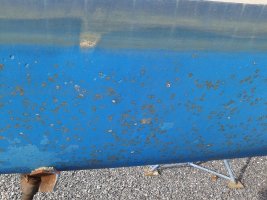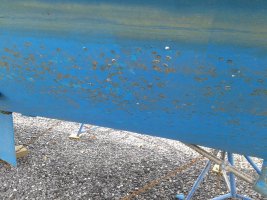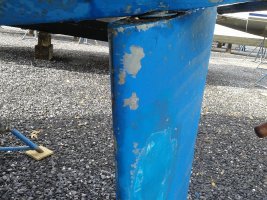Boat - 1983 E30+ in the middle Chesapeake.
Timeline:
Feb 2014, boat purchased, the broker says "Fresh coat of bottom paint". Doesn't specify what type, but appears some ablative type.
March 2016, old dock hand at the junk marina we're at says "Oh, yeah, just sand up what's on there a little, and put three really thin coats on, you'll be good for three seasons." We sand the hull until you can just barely see gelcoat through the very thin coat of existing paint. Put on three coats of Petit hydrocoat. Boat is launched.
July 2016 till October 2016, boat is hauled out and spend three months getting some fiberglass work done.
Oct. 2016 till Dec 2017, boat remains in the water over the winter, unused between november and April. Is used throughout the 2017.
She gets hauled out this week, and we find the following below the waterline. We have barnicle residue all over the hull and leading edge of the keel. We also have strips of the paint that have simply fallen off.
What the heck happened? And, more importantly, how do we move forward? A caveat to that, we have neither the time nor money for at least the next 12 months to strip this down to the gelcoat completely and start from scratch.
Given the time and money put into doing this job, it is more than a little disappointing to have this 18 months later.


Timeline:
Feb 2014, boat purchased, the broker says "Fresh coat of bottom paint". Doesn't specify what type, but appears some ablative type.
March 2016, old dock hand at the junk marina we're at says "Oh, yeah, just sand up what's on there a little, and put three really thin coats on, you'll be good for three seasons." We sand the hull until you can just barely see gelcoat through the very thin coat of existing paint. Put on three coats of Petit hydrocoat. Boat is launched.
July 2016 till October 2016, boat is hauled out and spend three months getting some fiberglass work done.
Oct. 2016 till Dec 2017, boat remains in the water over the winter, unused between november and April. Is used throughout the 2017.
She gets hauled out this week, and we find the following below the waterline. We have barnicle residue all over the hull and leading edge of the keel. We also have strips of the paint that have simply fallen off.
What the heck happened? And, more importantly, how do we move forward? A caveat to that, we have neither the time nor money for at least the next 12 months to strip this down to the gelcoat completely and start from scratch.
Given the time and money put into doing this job, it is more than a little disappointing to have this 18 months later.



